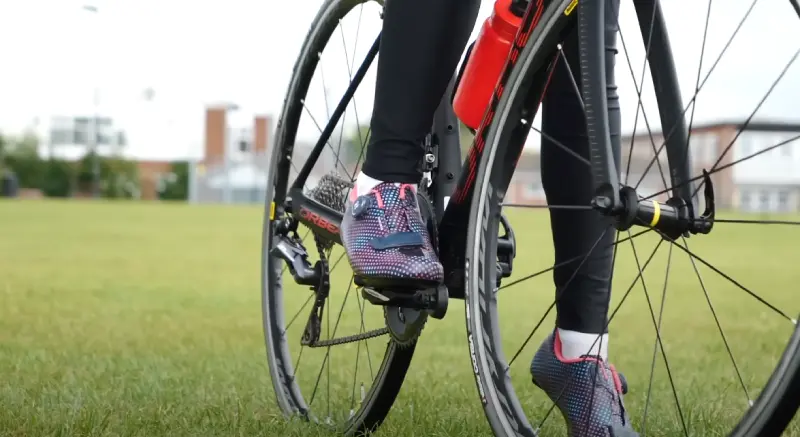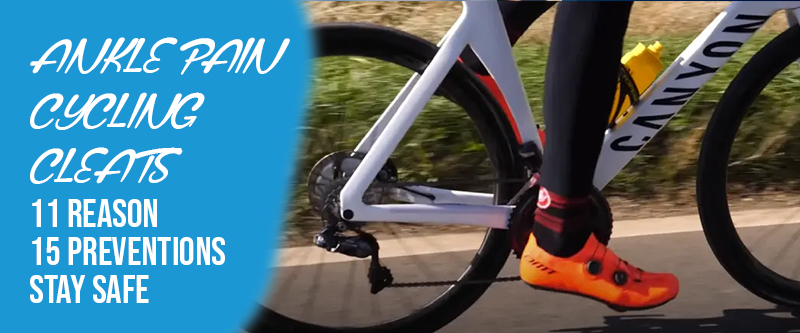Common cycling injuries include ankle pain caused by improperly set up cleats, knee pain due to poor bike fit or improper pedaling technique, and lower back pain from an incorrect riding posture.
Ankle pain while cycling can often be attributed to incorrect cleat positioning. If your cleats are too far forward, causing a toe-down pedaling also causes the tendon to inflame. It strains the Achilles, and incorrect lateral placement causes your feet to be too toed in or lead to ankle pain.
In this post, we’ll discuss the reasons for ankle pain with cycling cleats and cycling cleat ankle pain prevention methods.
Ankle Pain Cycling Cleats: 10 Causes & 15 Fixes

Cycling with cleats may cause ankle pain for committed cyclists. Pain on the outside of your foot while cycling is often due to a cleat position, which can be frustrating and affect your bike performance. Ankle pain when cycling with cleats can stem from a few reasons:
Cleats Are Not Correctly Positioned
Cleats that are not correctly positioned can cause unnecessary strain on the ankle joint, resulting in pain and discomfort. Some common causes of improper cleat positioning include incorrect shoe size, incorrect cleat placement, and worn-out shoes.
Cleats Are Off-Center
When the cleats are not aligned with the center of the foot, it causes an awkward pedaling motion, putting extra strain on the ankle. Due to off-center cleat placement, riders may develop serious injuries, including ankle sprains, Achilles tendonitis, and plantar fasciitis.
To prevent calf strain when cycling, position cleats to align the pedal axle with the ball of your foot. Avoid placing cleats too far forward or back to prevent straining the calf muscles.
Cleat Float
Cleat float, or the movement of the cleat while pedaling, can also contribute to ankle pain. Float allows the foot to move from side to side, leading to instability and a lack of control while cycling. Prolonged cycling with a significant amount of float may cause pain and inflammation in the ankle region.
Shoe Integrity
Cycling shoes support the foot and aid in transferring power from the leg to the pedal. When the shoe’s integrity is compromised, it no longer supports the foot and ankle, leading to pain and discomfort.
Inadequate Foot Support
Another common cause of ankle pain from cycling cleats is inadequate foot support. Ifyour shoes are too loose or don’t offer enough support, your foot can move around inside the shoe, leading to instability and discomfort.
Incorrect Pedaling Technique
The pedaling technique is crucial in preventing ankle injuries during cycling with cleats. If you are pedaling incorrectly, it stresses your ankles, resulting in pain and discomfort.
Tight or Weak Calf Muscles
Tight or weak calf muscles also cause ankle pain during cycling with cleats. A tight calf muscle can cause strain and tension on your ankles, while weak calf muscles can lead to instability and poor pedaling technique.
Foot or Ankle Injury
It is advised that if you have recently suffered a foot or ankle injury, it can also increase your risk of experiencing pain in your ankles when cycling in cleats. It’s essential to give your body time to heal before getting back on your bike and to speak with your doctor about any concerns regarding cycling with cleats.
Incorrect Shoe Size
Wearing shoes that are too small or too big may cause unnecessary stress and discomfort to your ankles. It’s important to find shoes that fit correctly and offer the proper support to avoid ankle pain.
Overuse
Overuse is another reason for cleat ankle pain. Cycling too frequently or for too long without adequate rest can cause stress and strain in your ankle joint.
Poor Bike Fit
Finally, a poor bike fit may cause ankle pain when cycling with cleats. If your bike is not fitted for your body type or riding style, it can stress your ankles unnecessarily.
Cycling Cleats Ankle Pain: 15 Prevention Methods

Cycling cleats worn for extended periods can cause ankle discomfort and pain. There are several effective prevention methods that you can adopt to prevent cycling cleat ankle pain.
Cleat Placement and Positioning
The positioning of your cleats on your cycling shoes will depend on your specific biomechanics. One way to determine the ideal position is to enlist the help of specialist biomechanics or medical professionals.
Choose the Right Cycling Shoe
A proper cleat placement depends on the type of cycling shoe you choose. When shopping for cycling shoes, go for shoes with a rigid sole. A stiff sole distributes pressure across your foot to prevent overloading or excessive tension on your ankle.
Adjustments to Consider
Various adjustments can be made to change the position of the cleats. One standard change is float, which allows side-to-side movement for the cleat while clipped into the pedal. This change is essential for preventing discomfort and hotspots.
Cleat Alignment Testing
It is crucial to test the alignment of your cleats before cycling after they have been adjusted. This can be done by clipping the cycling shoes into the pedals and pedaling for a few minutes. If you experience any discomfort or pain, adjust the cleats accordingly.
Correct Cleat Position
A cleat position that is too far forward when cycling can lead to foot pain. Positioning your cleats correctly on your shoes is crucial in preventing ankle pain when cycling. It is recommended to align the cleats on your ball of foot.. This position ensures proper power transfer and reduces stress on the ankles.
Proper Lateral Placement
Having your feet either too toed-in or toed-out can cause misalignment of your ankles, leading to pain and discomfort. Ensure that your feet are in a neutral position, aligned with your knees.
Adjust Saddle Height
Saddle height is an essential factor in preventing ankle pain after cycling. Adjusting the saddle height correctly can help relieve pressure and stress on your ankles.
Proper Shoe Fit
Invest in adequately fitted cycling shoes to help prevent ankle pain. A pair of shoes that is too tight or loose may cause discomfort and lead to injury. Ensure that you buy the right size for your feet.
Quality Cycling Insoles
Good quality cycling insoles can support your feet and improve your riding performance. With proper permission, your ankles will be subjected to less stress, which can help prevent ankle pain.
Use Wedges and Shims
Sometimes, you may need extra support to correct your cleat position. Wedges or shims, inserted beneath the cleat or the shoe, can help make necessary adjustments to ease ankle pain.
Bike Fit Review
It is advisable to review your bike fit to ensure that your position is correct and your posture is optimal. Your saddle height, handlebar, and cleat positioning must be in sync to help prevent ankle pain.
Avoid Excess Resistance
Riding with excess resistance can cause undue stress on your muscles and joints, leading to ankle pain. Pedal smoothly and rhythmically, without overexertion.
Loosen Straps

Over-tightened straps can cut off blood circulation to your feet, leading to numbness in the ankles. Don’t wear tight or loose shoes.
Take Breaks
Take frequent breaks during your cycling routine if you suffer from foot pain. Get off your bike, stretch, and give your feet a rest to prevent the onset of ankle pain.
Exercise for Strength and Flexibility
Strengthening your ankle muscles and stretching your calf muscles can go a long way in preventing ankle pain while cycling. The following are some exercises to consider for acquiring strength and flexibility.
- Toe hikes: Going up and down on one’s toes to stretch the Achilles tendon.
- Ankle eversion: Tie a band around your ankles and use your hips to roll the feet outwards. This exercises the ankle’s outward movement.
- Resistance bands: Wrap a resistance band around your foot and hold on to the end of the round. Flex your toes to provide tension, then rotate your ankle inwards for more resistance.
Conclusion
Ankle pain in cycling cleats can frustrate many cyclists, but it is not a reason to give up cycling. Understanding the reasons behind the pain and taking steps to prevent it is crucial to reducing the discomfort associated with ankle pain.
Some steps that cyclists can take include ensuring that the cleat’s position is adjusted correctly, selecting shoes with more flexible soles, or adding orthotics to increase foot support.
By implementing these measures, cyclists can continue to enjoy their sport without the interruption caused by ankle pain. Remember, consult a physician in case of intense pain or emergency.
FAQs
Are Ankle Cleats Necessary for Cyclists?
Ankle cleats are essential for cyclists as they improve power transfer efficiency by securely connecting the shoe to the pedal. Different cleat types suit various cycling disciplines, such as road cycling, mountain biking, and gravel riding, each providing specific benefits for performance and comfort. Properly setting up ankle cleats based on foot position and pedaling style can reduce injury risks and enhance your cycling experience.
What Treatment Options Are Available For Ankle Pain Caused By Cycling Cleats?
Pain can be reduced by resting, dressing, and elevating (RICE). Also, anti-inflammatory medication can be beneficial. If the pain persists, physical therapy or even surgery may be necessary. Getting a diagnosis and treatment from a qualified medical professional is always the best option.
How To Tape An Ankle Over Cleats?
Before taping an ankle over cleats, prepare the ankle with a pre-wrap to protect the skin. Apply anchor strips and tape stirrups for stability, then use the heel lock and figure 8 techniques to secure the ankle. Ensure the tape is firm but tight to avoid restricting blood flow.
How to Wrap An Ankle Over Cleats?
First, gather athletic tape or a specialized ankle wrap along with paddings like foam or gauze for protection over the ankle while wearing cleats. Start wrapping from the base of the foot above the cleats, then stabilize the ankle with a figure-eight pattern for support. Ensure the wrap is snug but not tight, allowing comfortable movement, and check periodically for adjustments during activity.
How Do You Know If Your Cleats are Too Far Back?
You’ll know you have too far back cleats if you feel a loss of power during pedaling, notice excessive shoe flex or experience discomfort or inefficiency in applying force. Professional bike fitters typically place the pedal spindle directly beneath the ball of your foot for optimal power transfer. Consulting a bike fitter can help assess your situation and make necessary adjustments.
Is There It Band Pain Caused By Cycling Cleat Position?
Yes, IT band pain can be caused by cycling cleat position. Malalignment due to an improper cleat position, especially excessive internal rotation (toe-in), can increase stress on the ITB, leading to discomfort and potential pain. Proper cleat positioning is crucial to prevent IT band issues while cycling.
Is There A Cycling Cleat Position That Prevents Peroneal Tendonitis?
Proper cleat positioning focusing on stability and preventing foot rotation can help reduce the risk of peroneal tendonitis in cycling. Ensuring the correct angle, fore-aft position, and proper alignment through professional bike fitting is crucial. Placing cleats further back to support the heel-drop technique can also aid in preventing peroneal tendonitis.


